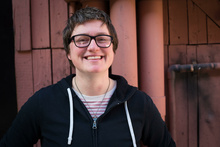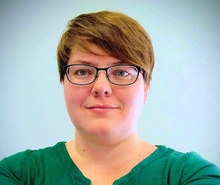
In the Fall 2024 semester, Lauren Haldeman and Tracy Meginnis taught the first run of a class titled “Editorial Practice” which took a turn from the classic English courses. Instead of focusing on books, it focused on the technological aspect of writing and creativity—website design, podcasting, HTML, and CSS. I was very excited to see this course pop up on the course options! In the past, I had learned a little bit about podcasting—in high school—and I created my own portfolio website using Wix, but I hadn’t ever been explicitly taught these skills in a hands-on manner.

“Editorial Practice” found its roots in conversation between Haldeman and previous English Department Chair Blaine Greteman, when he brought up Haldeman’s work on The Writing University. Haldeman found inspiration from her own experience.
“I wanted to make a class where every class we were we were making things and using skills that we were learning to make those things. And I wanted to focus on the specific use of a content management system because there are content management systems everywhere, being used for all sorts of websites. But I wanted to make it much more focused on the English department and on literature. And so, I came up with this idea that we'd all make online journals,” Haldeman said.
When creating the course, Meginnis and Haldeman separated the class into two parts, so the first half focused on website design and the second half focused on podcast and video creation. Haldeman taught the first half of the class, where she split the students into groups. Then, each group created their own idea for a literary magazine, and their task was to create a website for the magazine as a whole and individual web pages for each issue. To provide inspiration and understanding of what a literary magazine’s website can look like, Haldeman showed a variety of publications to the class, including The Iowa Review, New Moon Magazine, and The Rumpus. This assignment gave students the opportunity to learn and explore different platforms and software tools like Drupal, Canva, HTML, and CSS. Students were required to write a mission statement for the magazine, design a logo and cover template, and implement various elements into the website. My group created “The Witching Hour Review,” focusing on spooky stories, with a black and purple logo highlighting a witch graphic. Haldeman made the process fun and community-building while still learning a lot about the platforms.
“I want it to be like, ‘here's how you take what you (students) already have and what you've learned through workshops and through literature and through publications, and here's how you sort of channel it into all these actual jobs,’” Haldeman said.

Tracy Meginnis taught the second half of the course, and although students still worked in their original groups, there was a lot more individual work. Here, students listened to professional podcasts and studied what made them either good, or not to everyone’s taste. Following the study, the original groups created their own podcast concept and recorded one episode using the podcast studio in the Center for Language and Culture Learning (CLCL). Then, they split up the episode into smaller sections to edit the audio using Audacity while also picking out a 30 second clip of that audio to use in an original video. Students could create the video in a variety of styles—TikTok-style, slideshows, images and text, animation, kinetic typography, or anything else they could think of. One group in the class decided to create an audio play, which I’m excited to hear during presentations! I am creating a TikTok-style video mixed with kinetic typography.
“I've seen some similar comments [from students] that are sort of like somebody saying they tried to do something, and they couldn't figure it out, but then they did figure it out, and that's not only inspiring to me, but it's also evidence of such a really useful skill that is really hard to teach people—perseverance,” Meginnis said.
With the hands-on approach of this content management and creation course, students learn skills that are not only helpful in the classroom, but also applicable to the real world. Having increased computer skills, especially when facing graduation, increases an applicant’s chance of getting a job because of their ability to learn new systems, and their skills will open new job opportunities they wouldn’t have had otherwise. I’m looking forward to highlighting these skills on my resume!
Haldeman and Meginnis hope to teach “Editorial Practice” again and continue to make improvements and progress towards more learning opportunities.
Haldeman speculates on what she would have liked to do differently: “I think there was still more Drupal I would have liked to show you all. I mean, we got through the basics, but, even the last day, I was like, ‘oh, and then there's this,’ but I'd like to spend more time on the HTML and CSS. We only had one day of that, and I think it needs more time to sink in and to feel comfortable with it. It would be cool at some point to maybe get either a fake slush pile or a real slush pile and then actually choose pieces of work and make a real journal. But I feel like that would take a ton of that might be a whole other course in itself, right?”